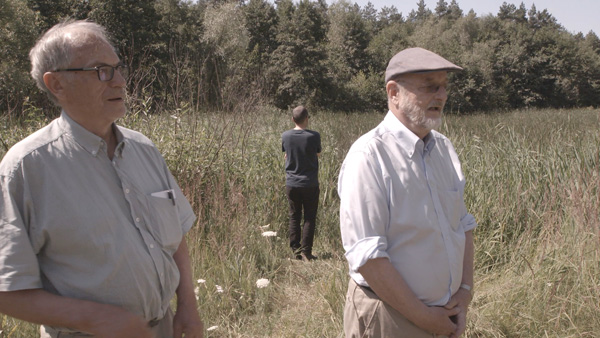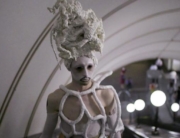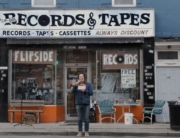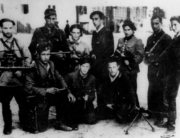
Che Smith meeting his father, Brian Tillman, for the first time in more than 20 years (Charles Miller)
Some of the most involving documentaries featured at previous Tribeca Film Festivals have creatively explored family histories, including The Flat and The Arbor, revealing and attempting to reconcile with the past. In two films this year, adult sons confronted their fathers, in memory and in person.
In My Father’s House
On Chicago’s South Side (President Obama’s home turf), Che “Rhymefest” Smith, rapper/radio talk show host, seeks out his paternal legacy when he and his devoted wife decide to buy his father’s childhood home and raise a family. After the ups and downs in his career, he is now an activist proponent of African-American men stepping up to fatherhood obligations, including to his several baby mamas. (Smith shared writing credit on the award-winning “Glory” song from Selma.)
He assumes his father is dead and that his phone calls to relatives will be like in those genealogical research TV shows: he’ll just learn more about his family history. But surprise! His father, Brian, who had spent only occasional time with him and Che’s addict teen mother before disappearing when Che was 12, is alive. And living as a homeless alcoholic on the street just a few blocks from where his wife teaches. Directors Ricki Stern and Annie Sundberg smoothly incorporate Che’s photographs and home video of their difficult reunion and follow the family over 18 months of wrestling with their responsibilities, guilt, and the potential for change.
Che sets out on an extended mission to lift his father up from his 20-year descent into alcoholism, and he guides Brian through an impressive array of dedicated organizations that can step-by-step lead him through sobriety and provide health care, education, and supportive housing. This documentary intimately demonstrates the pressing need for such services and how they can help a motivated man gain back his confidence and his life.
But the narrow focus on Che’s reconciliation with his own anger and resentments from the past (and his frustrations with Brian’s difficulties) treats as mere side stories the acute problems the others around him are trying to communicate. His wife, Donnie, is practically a saint in coping with all his family angst while she deals with infertility and running their nonprofit Donda’s House to help youth. For Brian, the family’s house itself is setting off horrible memories of the terrible abuse he suffered there at the hands of his own violent father. When Che proudly shows off each room they are fixing up, Brian can only see the specific tortures he endured there, though we get no other information on his background. How much does the ghost that haunts him in that house contribute to his relapses? Though Che admits to his own past struggles with addiction, he seems oblivious to this enduring family heritage that his father heroically tries to overcome.

Horst von Wächter, left, and Niklas Frank with Philippe Sands at the site of a mass grave (Sam Hardy)
A Nazi Legacy: What Our Fathers Did
Director David Evans follows an intriguing new path in what has become a familiar genre in which the descendants of Third Reich leaders look back decades later at their fathers’ dastardly official actions in contrast to their family’s domestic tranquility, such as in 2 Or 3 Things I Know About Him and Harlan: In The Shadow of Jew Süss. British Jewish human rights lawyer Philippe Sands explores the differing memories and attitudes of two septuagenarians, Austrian Horst von Wächter and German Niklas Frank, who have gotten to know each other well since their highly-placed Nazi fathers’ connection. Otto von Wächter carried out Hans Frank’s orders to implement the Final Solution in what is now Poland and Ukraine. Sands slowly counters (and insistently presses like the litigator he is) their more personal recollections during one-on-one tours of their childhood homesteads and in an awkwardly staged televised debate.
In Sands’ repetitive narration, the two old men are contrasted over and over (and over), as they sometimes struggle with English. Frank bitterly resents growing up in a dysfunctional family with a cold mother who went “shopping” for Jewish furs in the Krakow ghetto and a proud patriarch who showed off stolen masterpieces on his office wall, including a Da Vinci. Wächter has much fonder recall of his mother protecting his father from arrest after the war, and he adamantly rejects the moral concept and specific application of administrative responsibility for mass murder, choosing to focus on his father’s efforts to ameliorate orders. (Austria’s official amnesia of this era is now on display in Woman in Gold.)
This all seems like a richly illustrated (with letters, home movies and photographs) philosophy discussion until the three men visit the scenes of the crimes, where the past eerily meets present. From the burned out shell of a synagogue, where Sands realizes his grandparents worshipped, to a Holocaust memorial, they meet up with young and old Ukrainian nationalists, looking and sounding a lot like the Fascists Putin has propagandized about, who praise how Wächter senior actively supported them against the Soviets. It’s even more uncomfortable to remember that hidden Jews, whose survival under those same streets was portrayed in the film In Darkness, were more afraid of the Ukrainians than the Gestapo.






Leave A Comment